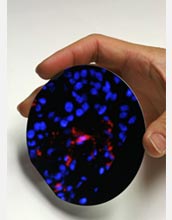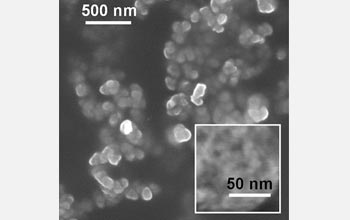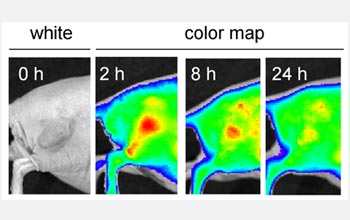All Images
Research News
Safer Nano Cancer Detector

Bright red-orange photoluminescence observed from porous silicon nanoparticles with human HeLa cells, magnified 1000 times and viewed in the reflection from a silicon wafer. Prepared from high-purity silicon wafers, these nanoparticles provide a nontoxic and biodegradable alternative to conventional quantum dots for in-vitro and in-vivo fluorescence imaging. The cell nuclei are stained blue.
Credit: Luo Gu, Ji-Ho Park, UCSD
Download the high-resolution JPG version of the image. (4.2 MB)
Use your mouse to right-click (Mac users may need to Ctrl-click) the link above and choose the option that will save the file or target to your computer.
Small is promising when it comes to illuminating tiny tumors or precisely delivering drugs, but many worry about the safety of nanoscale materials. Now, a team of scientists has created miniscule flakes of silicon that glow brightly, last long enough to slowly release cancer drugs, then break down into harmless by-products.
Credit: UCSD News Video

Luminescent porous silicon nanoparticles in a vial. The vial is being illuminated with an ultraviolet ("black") light, and the bright red-orange photoluminescence is observed. Prepared from high-purity silicon wafers, these nanoparticles provide a nontoxic and biodegradable alternative to conventional quantum dots for drug delivery and medical diagnostic applications.
Credit: Luo Gu, Ji-Ho Park, UCSD
Download the high-resolution JPG version of the image. (1.2 MB)
Use your mouse to right-click (Mac users may need to Ctrl-click) the link above and choose the option that will save the file or target to your computer.

The element symbol for silicon, "Si," spelled out on a fingertip with luminescent porous silicon nanoparticles. The finger is being illuminated with an ultraviolet ("black") light, and the bright red-orange photoluminescence is observed. Prepared from high-purity silicon wafers, these nanoparticles provide a nontoxic and biodegradable alternative to conventional quantum dots for drug delivery and medical diagnostic applications.
Credit: Luo Gu, Ji-Ho Park, UCSD
Download the high-resolution BMP version of the image. (2.5 MB)
Use your mouse to right-click (Mac users may need to Ctrl-click) the link above and choose the option that will save the file or target to your computer.

Electron microscope image of luminescent porous silicon nanoparticles, revealing the ~10 nanometer (nm) nanopores in the ~100 nm particles. The pores allow loading of therapeutic drugs, which can be carried to diseased tissues in the body by these nanoscale "mother ships." Prepared from high-purity silicon wafers, these nanoparticles provide a nontoxic and biodegradable alternative to conventional quantum dots for drug delivery and medical diagnostic applications.
Credit: Luo Gu, Ji-Ho Park, UCSD
Download the high-resolution JPG version of the image. (261 KB)
Use your mouse to right-click (Mac users may need to Ctrl-click) the link above and choose the option that will save the file or target to your computer.

Images of a mouse hindquarter containing a tumor. The first image is a regular photograph, and the other three, taken in a time series after injecting the mouse with dextran-coated silicon nanoparticles, show intensity color maps of the red emission channel. The red color shows the brightest fluorescence of the silicon nanoparticles, which initially localize in the tumor and then slowly disappear. Time after injection is indicated in the upper left of each image. The tumor is an MDA-MB-435 xenograft. Note that a strong signal is observed in the tumor two hours after injection, indicating significant passive accumulation by the EPR effect.
Credit: Ji-Ho Park, UCSD
Download the high-resolution JPG version of the image. (369 KB)
Use your mouse to right-click (Mac users may need to Ctrl-click) the link above and choose the option that will save the file or target to your computer.


